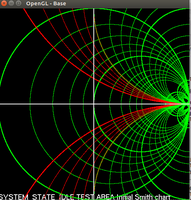I am constructing / drawing Smith chart using OpenGL (C programming language )
I am using normalized scale circles with diameter from 0 to 1.
I can draw 10 of these circles in log(10) scale - from 0 to 1 - in .1 intervals - no problem.
Now I need draw 10 of these circles , BUT they have to be scaled to fit into linear area from 0 to 1.41,
So in layman's terms - how do I scale log(0) - log(1) to log(0) - log(1.41) and maintain logarithmic scale?
I did try
double mark = -(log(index ));
mark *= 1.41;
but it "linearized / destroyed ' the overall logarithmic scale of the circles and did not fill 0 to 1.41 linear scale. .
I need to scale each circle and have them in logarithmic succession in same ratio as log 0 to log 1.
PS OpenGL /C handles the log(0) just fine.
I am using normalized scale circles with diameter from 0 to 1.
I can draw 10 of these circles in log(10) scale - from 0 to 1 - in .1 intervals - no problem.
Now I need draw 10 of these circles , BUT they have to be scaled to fit into linear area from 0 to 1.41,
So in layman's terms - how do I scale log(0) - log(1) to log(0) - log(1.41) and maintain logarithmic scale?
I did try
double mark = -(log(index ));
mark *= 1.41;
but it "linearized / destroyed ' the overall logarithmic scale of the circles and did not fill 0 to 1.41 linear scale. .
I need to scale each circle and have them in logarithmic succession in same ratio as log 0 to log 1.
PS OpenGL /C handles the log(0) just fine.
Last edited by a moderator:

